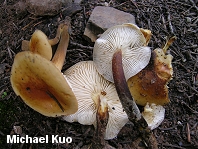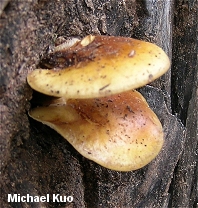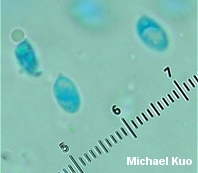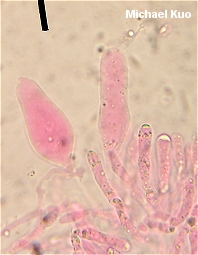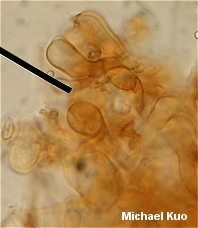| Major Groups > Gilled Mushrooms > Pale-Spored > Collybioid > Flammulina populicola |

|
Flammulina populicola [ Basidiomycetes > Agaricales > Marasmiaceae > Flammulina . . . ] by Michael Kuo Like its close cousin, Flammulina velutipes, Flammulina populicola has a fuzzy brownish stem, a white spore print, and a sticky, reddish brown to orangish brown cap. But there are five crucial things that separate the two species:
All of this means that Flammulina populicola is a separate species no matter how you define a "species," since the three most widely recognized "species concepts" for fungi are covered. It is a biological species because it can only mate with other Flammulina populicola specimens. It is a morphological species because it has observable physical features that separate it (though the features are microscopic). And it is a phylogenetic species because its DNA separates it from other Flammulina DNA. And, as is often the case, the mushroom's ecology appears to separate it, as well. It has evolved with the western poplars, and not in other North American ecosystems. Mushroom identifiers who lack DNA sequencers, fungal culture labs, and microscopes may be able to identify it with confidence on this basis alone. Description: Ecology: Saprobic on the stumps, logs, roots, and living wood of poplars (members of the genus Populus, like quaking aspen and narrowleaf cottonwood) from the Rocky Mountains westward; growing alone, scattered, gregariously, or (more commonly) in clusters; often appearing terrestrial when growing from root systems; late summer and fall (common during monsoon season in the Rockies). Collections on aspen from the Great Lakes area should be studied, I believe, as well as collections on Salix from the West Coast and elsewhere; it would not surprise me if these specimens of "Flammulina velutipes" turned out to be Flammulina populicola and resulted in an extension of the range for the species. Cap: 1-7 cm; convex, becoming broadly convex to flat; moist and sticky when fresh; bald; orangish brown to yellowish brown. Gills: Attached to the stem; whitish to pale yellow; crowded or close. Stem: 2-11 cm long; 3-5 mm thick; equal or larger towards base; tough; pale to yellowish brown or orange brown when young; becoming covered with a dark, brown to rusty brown or blackish velvety coating as it matures. Flesh: Whitish to yellowish; thin. Odor & Taste: Not distinctive. Chemical Reactions: Cap red with KOH. Spore Print: White. Microscopic Features: Spores 6-7.5 x 4.5-5 µ; smooth; elliptical; inamyloid. Pleurocystidia absent. Cheilocystidia scattered; clavate to ventricose; thin-walled; 40-50 x 10-15 µ. Pileipellis a hymeniform or nearly hymeniform ixotrichoderm above a cutis of branching, clamped, cylindric hyphae that are reddish brown in KOH; terminal elements clavate to subclavate; pileocystidia occasional, ventricose to fusoid-ventricose. REFERENCES: Redhead & Petersen, 1999. (Redhead & Petersen, 1999; Petersen, Hughes & Redhead, 2001.) Herb. Kuo 08140301, 08160301, 08080502. This site contains no information about the edibility or toxicity of mushrooms. |
© MushroomExpert.Com |
|
Cite this page as: Kuo, M. (2013, February). Flammulina populicola. Retrieved from the MushroomExpert.Com Web site: http://www.mushroomexpert.com/flammulina_populicola.html |
